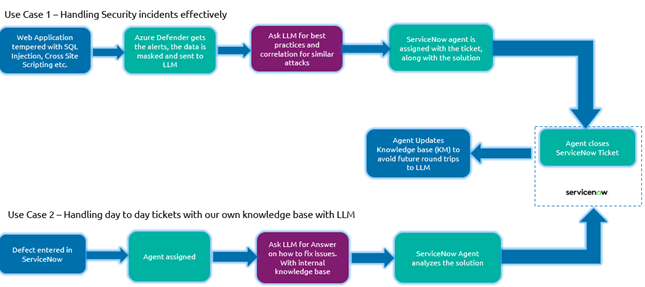Resolving security incidents effectively and efficiently is always a top priority for organizations. Unresolved security incidents can trigger alarm within the organization, potentially undermining client trust. Furthermore, it’s essential to foresee potential future complications while addressing these security incidents.”
Below are a couple of use cases that will help us understand how to resolve security incidents effectively.
Problem statement
Consider a scenario where an application hosted on the cloud is experiencing cross-site scripting attacks or SQL injection attacks.
The team will create a security incident and assign to a security engineer. The security engineer should resolve the ticket in a timely and effective manner. When resolving incidents, security engineer may refer to the client’s internal knowledge base for relevant documents.
Solution approach

Application Architecture Design
Below is the architecture design, featuring the main services used:
Azure App service: Hosts the web application connecting to SQL Server
Azure SQL Server: Stores the application data
ServiceNow: Used for ticket resolution
Azure Function: Exposes all HTTP REST API through serverless functions
Azure OpenAI: Used for making calls to LLM models
Azure Cognitive service: Connects to the clients internal knowledge base which is hosted in Azure Storage
Azure Communication Services Email: Sends email notification to ServiceNow
Others: Application Insights, Azure Defender and Log Analytics are used for monitoring

To sum up the solution. When a security incident occurs, Azure Defender alerts are sent to Azure Open AI for resolution. Here, through prompt engineering, Azure Open AI can foresee potential future issues.
Once the incident resolution is obtained, ServiceNow is notified via email using Azure Communication services Email. A ticket is created in ServiceNow, and assigned to the security agent, along with the possible resolution.
If the agent needs to refer client internal documentation for any reference, a request is sent to Azure Open AI via Azure Functions, which retrieves from Azure Storage through Azure Cognitive services. The search results will be specific to the needs of the security agent.
By using these approaches, organizations can boost productivity boost and resolve tickets faster.

 English | EN
English | EN 